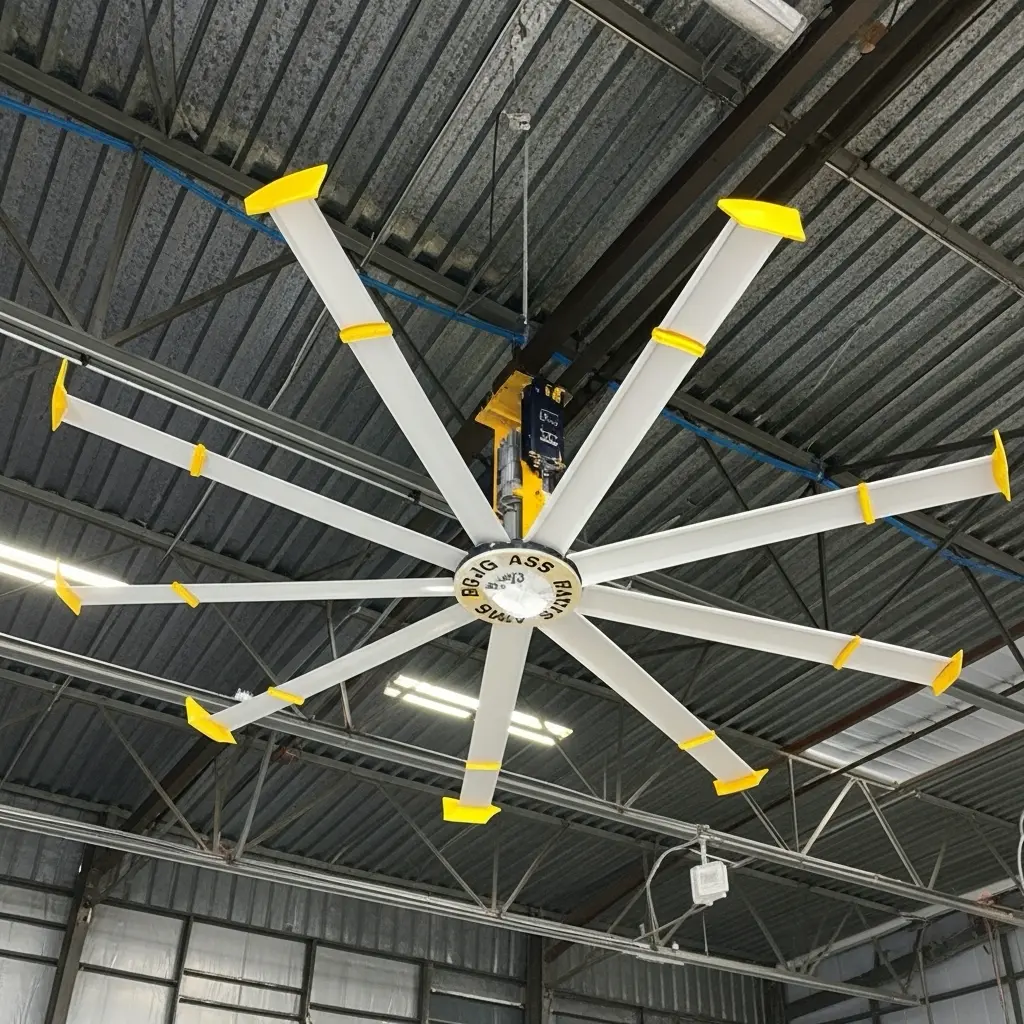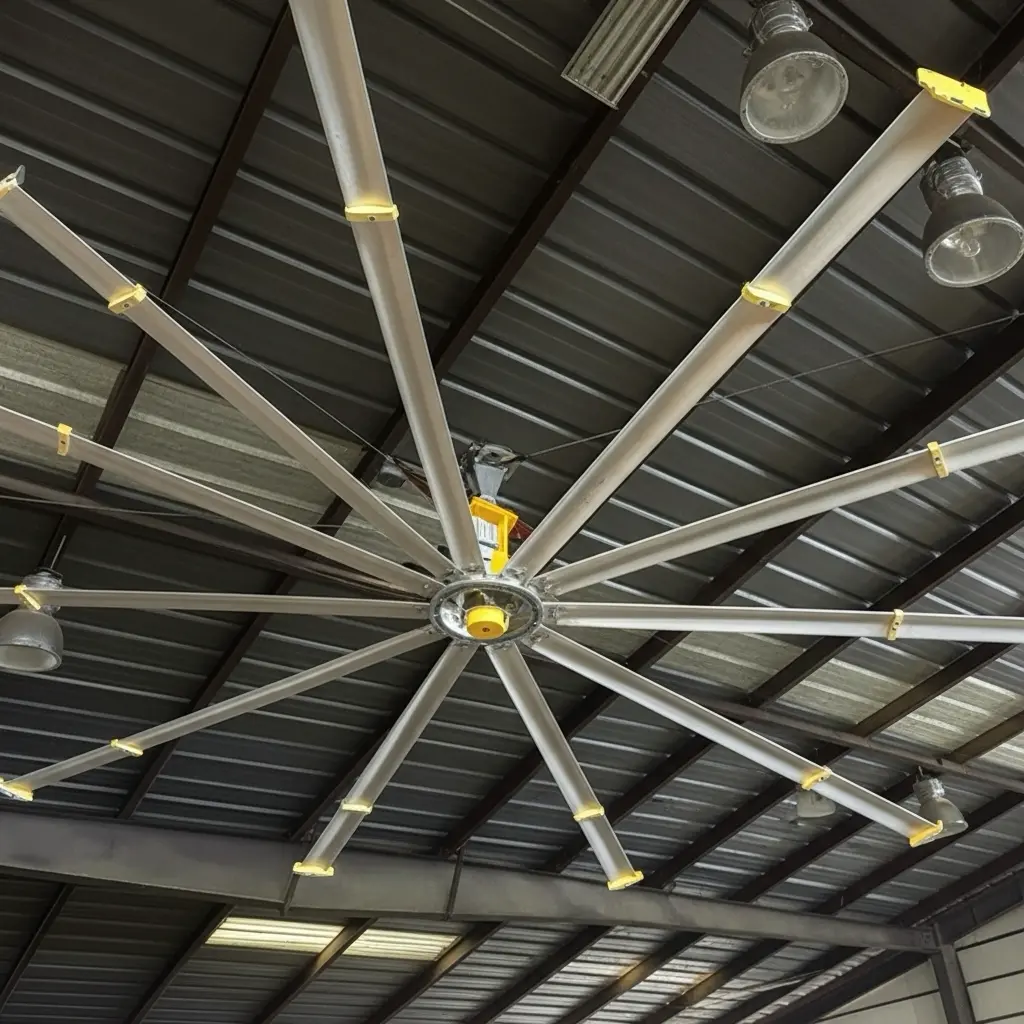Discover everything about HVLS industrial fans how they work, why they’re essential for large spaces, and how to choose the best one for your warehouse, gym, or factory.
Table of Contents
HVLS industrial fans (High Volume Low Speed fans) are revolutionizing airflow management in commercial and industrial facilities across Canada, the U.S., and beyond. Unlike small, high-speed fans that create narrow air streams, HVLS fans move vast amounts of air slowly and efficiently, improving comfort, air quality, and energy savings. From warehouses and gyms to barns and factories, these giants redefine climate control with minimal energy use.

What Are HVLS Industrial Fans?
The term HVLS stands for High Volume, Low Speed — meaning the fan moves a massive amount of air (high volume) at a slow rotational rate (low speed). Typical diameters range from 8 to 30 feet, generating a steady air column that spreads horizontally once it hits the floor. This “horizontal floor jet” effect keeps temperatures consistent and occupants comfortable throughout the building.
Unlike conventional fans that rely on velocity, HVLS fans depend on volume. Their wide blades gently circulate the air in every corner of a facility, creating a consistent airflow layer from ceiling to floor. This movement eliminates hot and cold spots and helps distribute conditioned air more evenly — especially beneficial in large buildings where HVAC alone struggles to maintain uniform temperature.
How HVLS Fans Work
According to LED Lighting Supply’s Buyer’s Guide, HVLS fans work through destratification — the process of breaking down temperature layers that naturally form in tall spaces. Warm air rises, but HVLS fans push it down and mix it with cooler air below, stabilizing temperatures and reducing the load on heating systems. In summer, the same fan provides a cooling breeze, reducing perceived temperature by up to 10°F without lowering the thermostat.
Each revolution of a large HVLS fan can move up to 400,000 cubic feet of air per minute. Instead of turbulent gusts, it produces a smooth, gentle airflow covering an area up to 20,000 square feet — enough to replace dozens of smaller floor fans. Manufacturers like Big Ass Fans and MacroAir emphasize that their fans not only cool but also improve air quality by dispersing humidity, dust, and fumes in industrial environments.
Benefits of HVLS Industrial Fans
1. Energy Efficiency and Cost Savings
HVLS fans can cut HVAC energy costs by 20–30%. When used with air conditioning, they allow you to raise the thermostat a few degrees while maintaining comfort. During winter, reversing the fan direction helps recirculate warm air trapped at the ceiling, reducing heating bills. These benefits make HVLS fans an energy-efficient investment eligible for certain Canadian and U.S. tax incentives for commercial energy upgrades.

2. Improved Comfort and Productivity
Warehouses, gyms, and factories often suffer from hot, stuffy conditions that reduce worker efficiency. By enhancing air circulation, HVLS fans create a more comfortable environment, reducing fatigue and heat-related stress. According to MarutAir, improved comfort can lead to measurable increases in productivity and safety especially in industries requiring physical labor or high heat tolerance.
3. Year-Round Performance
HVLS fans aren’t seasonal equipment. In winter, their destratification effect can cut heating energy use by up to 25%. During transitional seasons, they maintain comfort even without running HVAC systems. Models with automatic temperature sensors or smart controllers adjust rotation speed based on ambient conditions, optimizing airflow 24/7.
4. Health and Air Quality
Large industrial spaces can accumulate fumes, moisture, and dust. Continuous airflow from HVLS fans dilutes airborne contaminants and prevents condensation on equipment and walls — an essential benefit in food production, agriculture, and manufacturing. Better airflow also reduces odors and supports compliance with occupational air-quality standards.
5. Quiet, Reliable Operation
Despite their size, modern HVLS fans operate quietly — often below 55 dB. Manufacturers like MarutAir call them “quiet giants.” This makes them suitable even for noise-sensitive environments such as event halls or training centers. Most use direct-drive motors, which are more efficient and have fewer moving parts than traditional gear motors, resulting in less maintenance and longer lifespan.
Applications of HVLS Industrial Fans
- Warehouses & Distribution Centers: Maintain consistent temperature and reduce energy costs.
- Manufacturing Facilities: Remove hot air pockets near machinery, enhance worker comfort.
- Gyms & Recreation Centers: Improve air circulation and comfort during workouts.
- Barns & Agricultural Buildings: Keep livestock cool, reduce humidity and mold.
- Airplane Hangars: Distribute warm and cool air evenly across large open areas.
Choosing the Right HVLS Fan
Based on insights from HVLS Fans Asia and MacroAir’s Good/Better/Best guide, here’s what to consider when selecting your HVLS system:
- Ceiling Height & Floor Area: Fans between 12–24 ft in diameter suit most commercial spaces. Choose larger fans for ceilings over 25 ft.
- Material & Motor Type: Aluminum blades and direct-drive motors ensure longevity and quiet operation.
- Energy Rating: Look for models with variable frequency drives (VFD) and efficient motors (EC or PMSM).
- Controls: Advanced systems offer remote, smartphone, or building automation integration.
- Warranty & Service: Quality manufacturers provide 10–15-year motor warranties and nationwide support.

Installation and Maintenance
Installing HVLS fans requires secure ceiling structures and professional expertise. It’s comparable in principle to installing a Hampton Bay ceiling fan but on a much larger scale. Certified technicians handle the mounting, electrical wiring, and balancing. Once installed, HVLS fans require minimal maintenance — periodic cleaning, bolt inspection, and controller testing once or twice a year.
HVLS Fans and HVAC Systems
Many facility managers wonder whether HVLS fans can replace HVAC systems. The answer is: not entirely, but they work together beautifully. HVLS fans complement HVAC by circulating conditioned air evenly, allowing thermostats to be set higher or lower with less energy use. According to Hunter Industrial’s placement guide, placing fans at least 20 ft above the floor and spacing them 60–100 ft apart ensures full coverage and maximum efficiency.
Canadian and Quebec Considerations
In cold climates like Quebec, HVLS fans help destratify warm air trapped near the ceiling. This process can significantly reduce heating costs during long winters. Some provinces also offer energy-efficiency incentives for commercial buildings upgrading ventilation systems. Be sure to check local rebate programs or government grants under “commercial energy retrofits.”
Cost and ROI
While HVLS fans may cost more upfront (typically $4,000–$12,000 per unit installed), the ROI is strong. Businesses often see payback in under three years from reduced energy bills alone. When factoring in improved comfort, productivity, and HVAC longevity, the value becomes even more significant.
FAQs About HVLS Industrial Fans
- Q: Can HVLS fans replace air conditioning?
A: They don’t cool the air directly but reduce perceived temperature and energy load on HVAC systems. - Q: How many HVLS fans do I need?
A: It depends on your ceiling height and area. One 24-ft fan covers ~20,000 sq ft effectively. - Q: Are HVLS fans noisy?
A: No, most operate below 55 dB — quieter than conversation level. - Q: Can I install an HVLS fan myself?
A: Due to size and safety factors, professional installation is strongly recommended. - Q: Do HVLS fans work in winter?
A: Yes — running them in reverse destratifies warm air and reduces heating costs.
Conclusion
HVLS industrial fans are one of the smartest energy-efficiency upgrades a commercial facility can make. They enhance comfort, protect equipment, and reduce operational costs year-round. Whether you manage a warehouse in Ontario, a gym in Alberta, or a dairy barn in Quebec, the right HVLS fan can improve air quality and save money while keeping your team comfortable and productive. If you’re planning your next upgrade, consult an expert to size and install the perfect system — and enjoy cleaner, cooler air in your workspace for years to come.

